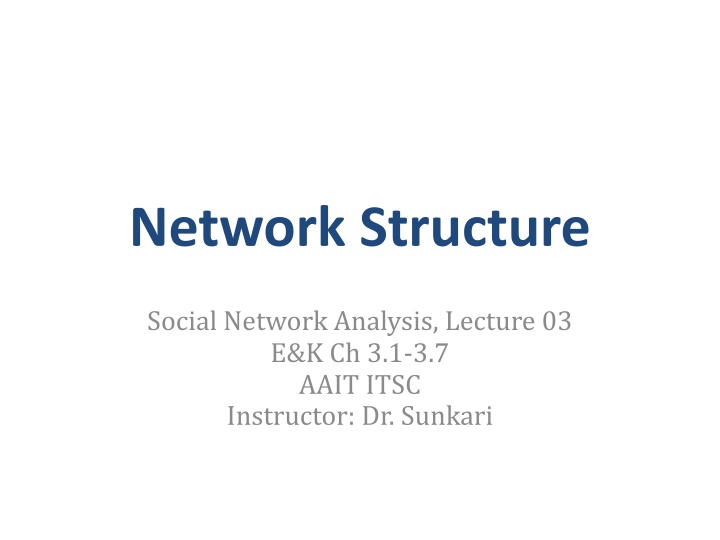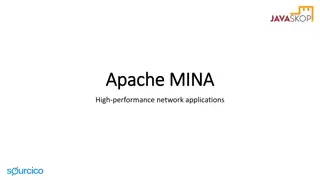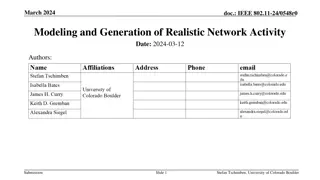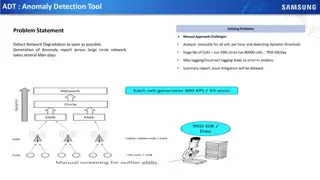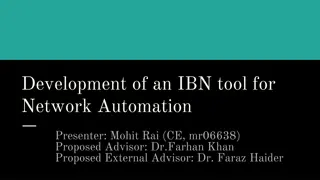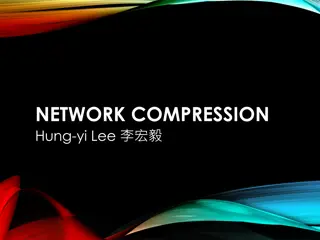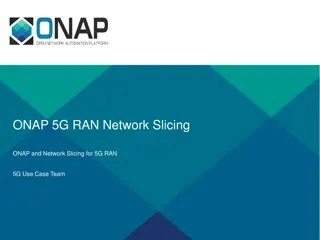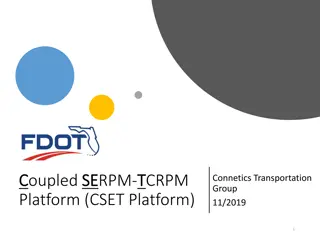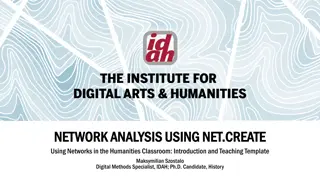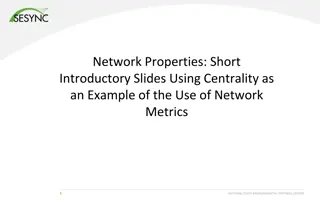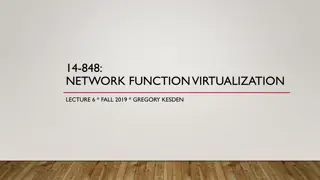Network Structure
Dive into basic definitions, ties, bridges in large-scale data, node-level metrics, components, giant components, triadic closure, clustering coefficients, cliques, and more. Explore concepts like connectedness, components, and the giant component in a global social network.
Download Presentation

Please find below an Image/Link to download the presentation.
The content on the website is provided AS IS for your information and personal use only. It may not be sold, licensed, or shared on other websites without obtaining consent from the author.If you encounter any issues during the download, it is possible that the publisher has removed the file from their server.
You are allowed to download the files provided on this website for personal or commercial use, subject to the condition that they are used lawfully. All files are the property of their respective owners.
The content on the website is provided AS IS for your information and personal use only. It may not be sold, licensed, or shared on other websites without obtaining consent from the author.
E N D
Presentation Transcript
Network Structure Social Network Analysis, Lecture 03 E&K Ch 3.1-3.7 AAIT ITSC Instructor: Dr. Sunkari
Outline (Review) Syllabus Network Structure Basic definitions Ties & Bridges in Large-scale data Node-level metrics
Basic definitions: components, giant component, triadic closure, clustering coefficient, cliques, bridges, local bridges NETWORK STRUCTURE
A set of objects/ individuals Review: Network=Graph Dfn: A graph G is a tuple (V, E) Edges in E connect vertices in V Set of links between objects Dfn: A neighbor set N(v) is the set of vertices adjacent to v. Set of vertices u = ( ) { | ( , v , ) } N v u V u v u E not v itself Neighbors of v There s an edge
Review: Connectedness Not edge! Dfn: A graph (or subgraph) is connected if there is a path between each pair of nodes. If no path, this is disconnected.
Components Dfn: a connected component is a subset S of nodes where: 1. Every node in S has a path to every other | { u S v Scomp = path , ( , )} S u v 2. S is not part of a larger subset S where property #1 holds
Giant Component A giant component: connected component that contains a significant fraction of all the nodes Ex: Real-world social network Ex: Random graphs (Erdos-Renyi model more later)
THINK-PAIR-SHARE: Do you expect that you are part of a giant component in the global social network? Why or why not?
Triadic closure If two people in a social network have a friend in common, then there is an increased likelihood that they will become friends themselves ... - Rapoport 1953 Why? Opportunity Trust Incentive How prevalent is triadic closure in a graph? G B C F A E D
Clustering Coefficient Dfn: The (overall) clustering coefficient of a node v is the probability that u1, u2 (two randomly selected neighbors of v) are themselves neighbors. neighbors of v that are linked v # {( , ) | , ( ), ( )} u u E u u u N v u N v 1 2 1 2 1 2 = G ( ) Cl v # {( , | ) 2 , ( ), ( )} u u u u u N v u N v 1 1 2 1 2 Any 2 neighbors of v
Cliques Dfn: A clique is a maximal, completely connected subgraph of a given graph. B B B C A C A C A D D D
INDIVIDUAL EXERCISE: What is the clustering coefficient of this graph? What are the cliques? G B C F A E D
Bridges Dfn: An edge e is a bridge in the graph G if G e has more components than G What about giant components?
Local Bridges Dfn: An edge e = (v,u) is a local bridge in the graph G if pathG-e(v, u) pathG(v, u) > 2 span of local bridge i.e., no friends in common
GROUP DISCUSSION: Not all edges ( ties ) are created equal. To find a job, which would be more useful: A good friend? Or an acquaintance? strong tie weak tie
Strong Triadic Closure Property Node v violates the Strong Triadic Closure Property if: it has strong ties to 2 other nodes u1 and u2 and there is no edge at all (strong or weak) between u1 and u2 Node v satisfies the Strong Triadic Closure Property if it does not violate it.
Local Bridges must be Weak Ties! What if: A has strong ties A = local bridge Contradiction! of Strong Triadic Closure Strong and weak are imprecise! How does this look in the real world?
Tie Strength Define strong and weak ties? Weak : e.g., follow on Facebook (FB) Strong : e.g., reciprocal FB messages Quantify strong and weak ties? E.g., # likes, messages, etc
Neighborhood Overlap Dfn: The neighborhood overlap of an edge e = (v, u) is: shared neighbors (i.e., triadic closure) | ( ) ( ) | N v N u u v = neighborho odOverlap( ) v,u | ( ) ( ) | N v N u u v all neighbors of either node
INDIVIDUAL EXERCISE: What is the neighborhood overlap of : 1. BC edge? 2. AB edge? G B C F A E D
Node-level Metrics Social Network Analysis, Lecture 03b E&K Ch 3.1-3.7 AAIT ITSC Instructor: Dr. Sunkari
Centrality: degree, betweenness, closeness, information; Eccentricity NODE-LEVEL METRICS
Centrality How does a node relate to the overall network? In real-life Information flow Bargaining power Influence
Review: Node Degree Dfn: The node degree is the number of neighbors a node has. di(G) = |N(i)| w.r.t. adjacency matrix: adjacency matrix value V j A deg=3 E B A 0 1 0 0 1 B 1 0 1 0 0 C 0 1 0 0 1 D 0 0 0 0 1 E 1 0 1 1 0 D C A B C D E = G ( ) d a , i i j pick row i
Review: Local Bridges Dfn: An edge e = (i,j) is a local bridge in the graph G if pathG-e(i, j) pathG(i, j) > 2 span of local bridge i.e., no friends in common
Degree Centrality How connected is the node? Node degree, scaled to [0,1] d G C i ( ) G degree of node i = D ( ) i # of nodes in network (not i) | | 1 V Missing: node location?
Betweenness Centrality How important is this node in connecting others? # shortest paths between k and j that include i # shortest paths between k and j ( , / ) j ( , ) P k P k j ; i = B i ( ) i C G (| | )(| 1 | / ) 2 2 V V { , } j k k j
Closeness Centrality How easily can a node reach others? Simple: Inverse average distance = i i , distance( | | 1 V # nodes (not i) C G ( ) C i ) j avg. distance from node i j Decay centrality: j i If -> 0? If -> 1? Degree centrality distance( , ) i j Component size decay parameter in [0,1]
Information Centrality How well can the network respond if a node is deactivated? Measure in graph efficiency: 1 ) ( 1 G = E G | | (| | ) 1 V V id , , i j i j , j Compare the change in efficiency = [ ] E [ ] ' E E G E G = CI ( ) G i graph G without node i or corresponding edges [ ] E G
